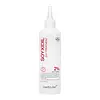What's inside
What's inside
 Key Ingredients
Key Ingredients

 Benefits
Benefits

 Concerns
Concerns

 Ingredients Side-by-side
Ingredients Side-by-side

Water
Skin ConditioningDipropylene Glycol
HumectantGlycereth-26
HumectantPropanediol
SolventGlycerin
Humectant1,2-Hexanediol
Skin ConditioningHydroxyacetophenone
AntioxidantArginine
MaskingCarbomer
Emulsion StabilisingPolyglyceryl-10 Laurate
Skin ConditioningXanthan Gum
EmulsifyingDipotassium Glycyrrhizate
HumectantEthylhexylglycerin
Skin ConditioningDisodium EDTA
Eucalyptus Globulus Leaf Oil
PerfumingPanthenol
Skin ConditioningButylene Glycol
HumectantBisabolol
MaskingSodium Hyaluronate
HumectantAdansonia Digitata Seed Extract
Skin ConditioningCrithmum Maritimum Extract
Skin ConditioningLeontopodium Alpinum Callus Culture Extract
AntioxidantCalendula Officinalis Flower Extract
MaskingAnastatica Hierochuntica Extract
AstringentWater, Dipropylene Glycol, Glycereth-26, Propanediol, Glycerin, 1,2-Hexanediol, Hydroxyacetophenone, Arginine, Carbomer, Polyglyceryl-10 Laurate, Xanthan Gum, Dipotassium Glycyrrhizate, Ethylhexylglycerin, Disodium EDTA, Eucalyptus Globulus Leaf Oil, Panthenol, Butylene Glycol, Bisabolol, Sodium Hyaluronate, Adansonia Digitata Seed Extract, Crithmum Maritimum Extract, Leontopodium Alpinum Callus Culture Extract, Calendula Officinalis Flower Extract, Anastatica Hierochuntica Extract
Propylene Glycol
HumectantAlcohol Denat.
AntimicrobialMyristyl Alcohol
EmollientBehentrimonium Chloride
PreservativeParfum
MaskingWater
Skin ConditioningButylene Glycol
HumectantGlycerin
HumectantGlycine Soja Germ Extract
Emollient1,2-Hexanediol
Skin ConditioningOryza Sativa Extract
AbsorbentSea Salt
AbrasiveAspergillus Ferment
Skin ConditioningEthylhexylglycerin
Skin ConditioningHydroxypropyltrimonium Hyaluronate
Hydrolyzed Vegetable Protein
Skin ConditioningMaltodextrin
Absorbent3-O-Ethyl Ascorbic Acid
Skin ConditioningBiotin
AntiseborrhoeicHydroxypropyl Cyclodextrin
MaskingCopper Tripeptide-1
Skin Conditioning7-Dehydrocholesterol
Emulsion StabilisingPropylene Glycol, Alcohol Denat., Myristyl Alcohol, Behentrimonium Chloride, Parfum, Water, Butylene Glycol, Glycerin, Glycine Soja Germ Extract, 1,2-Hexanediol, Oryza Sativa Extract, Sea Salt, Aspergillus Ferment, Ethylhexylglycerin, Hydroxypropyltrimonium Hyaluronate, Hydrolyzed Vegetable Protein, Maltodextrin, 3-O-Ethyl Ascorbic Acid, Biotin, Hydroxypropyl Cyclodextrin, Copper Tripeptide-1, 7-Dehydrocholesterol
Ingredients Explained
These ingredients are found in both products.
Ingredients higher up in an ingredient list are typically present in a larger amount.
1,2-Hexanediol is a synthetic liquid and another multi-functional powerhouse.
It is a:
- Humectant, drawing moisture into the skin
- Emollient, helping to soften skin
- Solvent, dispersing and stabilizing formulas
- Preservative booster, enhancing the antimicrobial activity of other preservatives
Butylene Glycol (or BG) is used within cosmetic products for a few different reasons:
Overall, Butylene Glycol is a safe and well-rounded ingredient that works well with other ingredients.
Though this ingredient works well with most skin types, some people with sensitive skin may experience a reaction such as allergic rashes, closed comedones, or itchiness.
Learn more about Butylene GlycolEthylhexylglycerin (we can't pronounce this either) is commonly used as a preservative and skin softener. It is derived from glyceryl.
You might see Ethylhexylglycerin often paired with other preservatives such as phenoxyethanol. Ethylhexylglycerin has been found to increase the effectiveness of these other preservatives.
Glycerin is already naturally found in your skin. It helps moisturize and protect your skin.
A study from 2016 found glycerin to be more effective as a humectant than AHAs and hyaluronic acid.
As a humectant, it helps the skin stay hydrated by pulling moisture to your skin. The low molecular weight of glycerin allows it to pull moisture into the deeper layers of your skin.
Hydrated skin improves your skin barrier; Your skin barrier helps protect against irritants and bacteria.
Glycerin has also been found to have antimicrobial and antiviral properties. Due to these properties, glycerin is often used in wound and burn treatments.
In cosmetics, glycerin is usually derived from plants such as soybean or palm. However, it can also be sourced from animals, such as tallow or animal fat.
This ingredient is organic, colorless, odorless, and non-toxic.
Glycerin is the name for this ingredient in American English. British English uses Glycerol/Glycerine.
Learn more about GlycerinWater. It's the most common cosmetic ingredient of all. You'll usually see it at the top of ingredient lists, meaning that it makes up the largest part of the product.
So why is it so popular? Water most often acts as a solvent - this means that it helps dissolve other ingredients into the formulation.
You'll also recognize water as that liquid we all need to stay alive. If you see this, drink a glass of water. Stay hydrated!
Learn more about Water